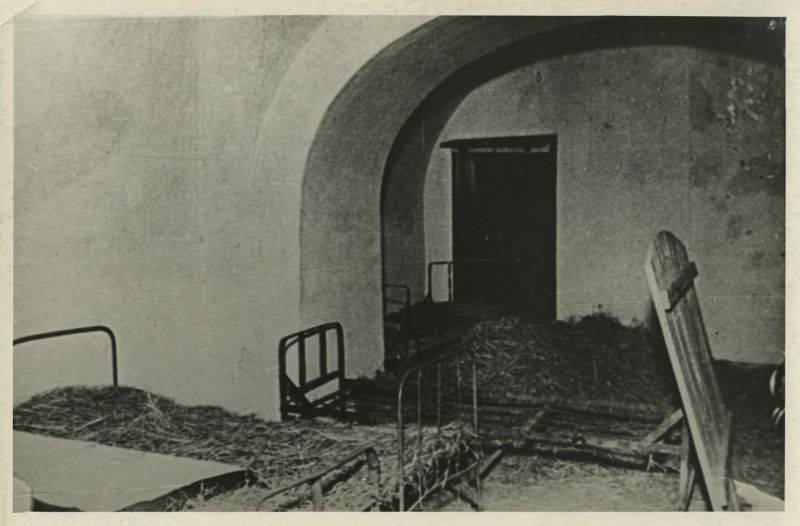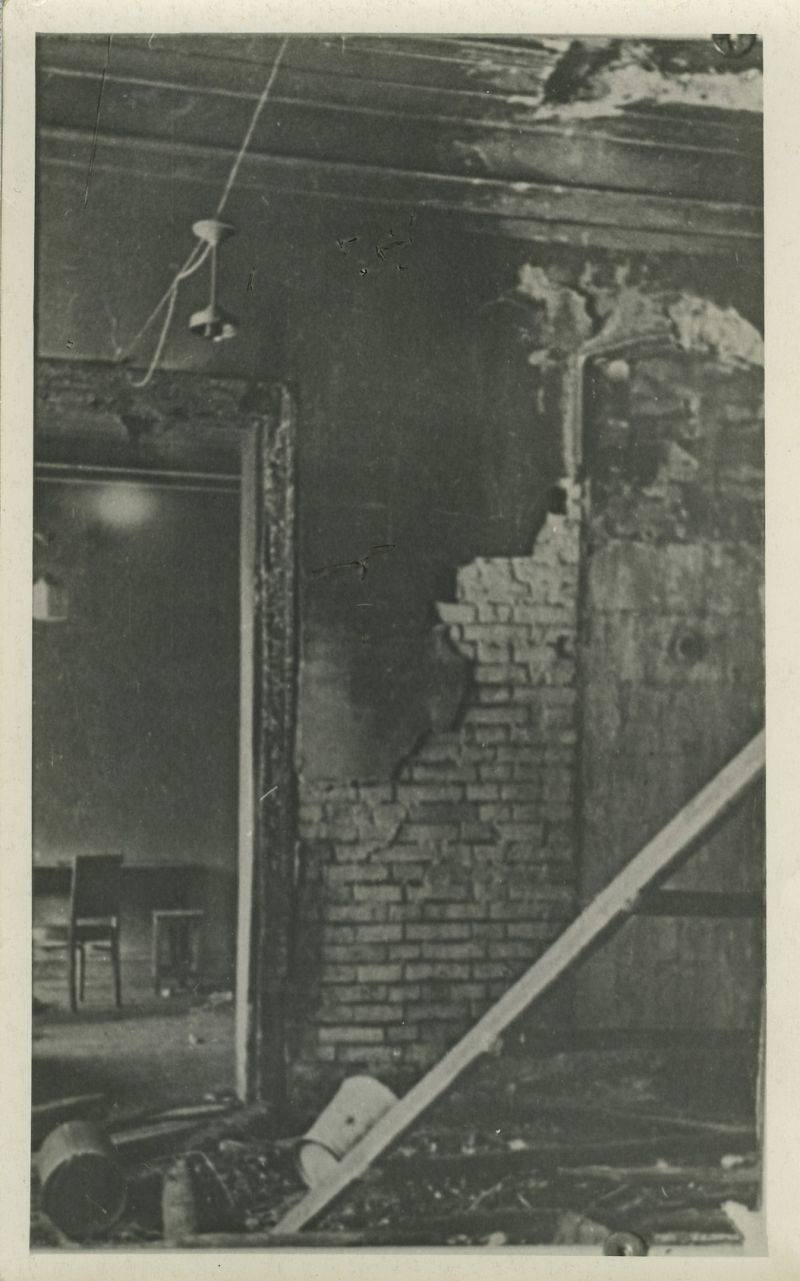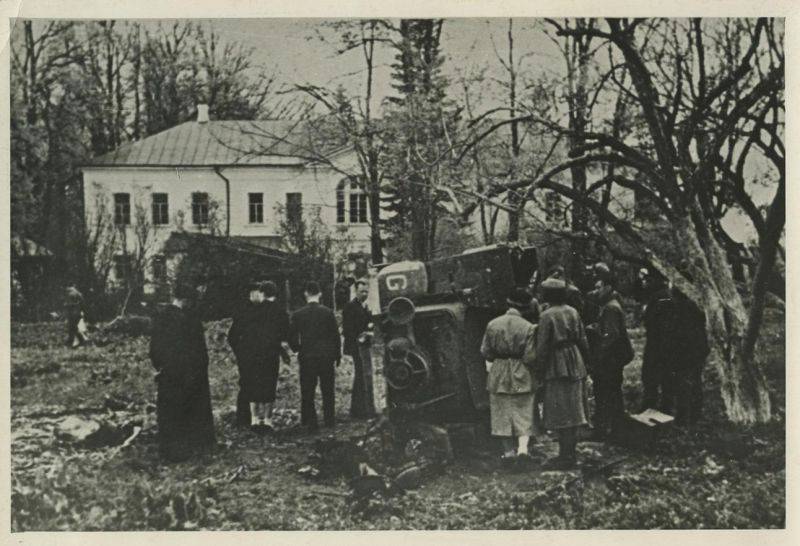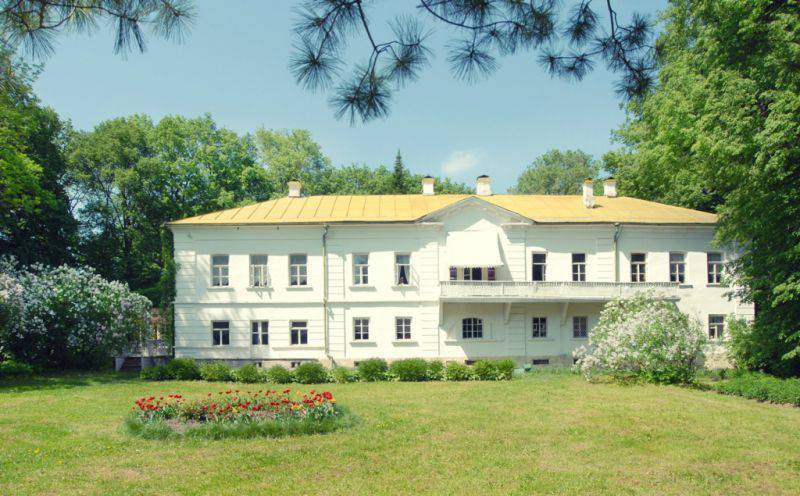Yasnaya Polyana during the occupation period
I heard from one of my peers: so in this figure most of the regional museums are not so important. But can a memory be regional or regional? After all, by and large, all events stories occur in cities and villages.
Today - the story of the military fate of the museum-estate of Leo Tolstoy "Yasnaya Polyana", in the Tula region. And we will start it with the memories of Lipchanin, a war correspondent and photographer, holder of the Order of the Patriotic War, Ivan Alexandrovich Narcissov, who had walked with a rifle and watering can all through the war and reached Berlin. Photos and memoirs of Ivan Alexandrovich entered the five-volume work "The Great Patriotic War in photographs and documents." And these lines are from his diary.
“... I remember how quickly the message about the desecration of Yasnaya Polyana by the Nazi barbarians spread by the“ soldier’s phone ”. The details were like that.
The museum of the great writer Lev Nikolayevich Tolstoy was turned into barracks by the fascists, the cabinets were cracked, the furniture was disfigured, things were stolen. And when the enemies retreated, they set fires in three rooms. This news caused a wave of anger in the hearts of the warriors. The fighters avenged the Nazis for the brutal bombing of workers' settlements, for burnt huts, for the tears of their mothers, for the outraged Yasnaya Polyana, where Lev Nikolayevich lived for more than fifty years and created his largest works.
And when I now, in peacetime, re-read “War and Peace”, “Sevastopol Stories”, I always remember the roads of the past war. I heard one battery commander - by the way, after all, Tolstoy also served during the Caucasian war in artillery - launching a projectile at the enemy, each time exclaiming: "For Anna Karenina"! For "War and Peace"! ". Today, I proudly think of those with whom the soldiers' journalistic friendship brought me together, about the people, whose mighty spirit is embodied in the writer's works ... "
... In the autumn of 1941, it became clear that the fascists were about to occupy the estate territory. And the director of the museum, the granddaughter of Lev Nikolaevich Sofya Andreyevna Tolstaya-Yesenina, began preparations for the evacuation of those exhibits that were in the house of the writer. In a hurry, a lot of work was done in just a few days: the museum's valuables - 110 boxes were selected and carefully packed! They were loaded onto the train, which in mid-October brought the exhibits to Tomsk, until the end of the war they were kept in the scientific library of Tomsk State University.
And in Yasnaya Polyana, meanwhile, they were waiting for the enemy to advance. Red Army men settled in the manor. Explosions are heard, the voices of anti-aircraft guns, the noise of motors — the enemy was torn to Tula. But even in such a tense wait our fighters tried to take care of the museum, many asked the guides to tell about the life of the great writer, went to his grave.
... The 2nd tank Guderian's army. The Germans came close to Tula, took the city in a half ring. No matter how our soldiers fought, they had to retreat. October 29 (according to some sources - on the 30th) on October the invaders broke into the estate - for a long 47 days. In the book of reviews, where only good words, wishes, impressions “lived” before, barbaric lines appeared: “The first three Germans in the campaign against Russia” ... What were they, these “three first Germans” - silly or simply overflowing with their own significance and the desire to ruin everything around, since they managed to write this? But, as it turned out, this is only the beginning.
On November 1, Heinz Guderian himself entered the house of Tolstoy. He did not inspect anything, just went through the house. But the officers walking with him took two photographs of Lev Nikolayevich with them (in memory of Guderian). And the very next day the upper floor became an officer's hostel. In the house Volkonsky fascists staged a hospital. They housed the wounded in the Literary Museum. On the estate they practiced shooting: they beat goats, chickens and even cows. It also cut up carcasses.
In the room of Sergei Tolstoy, the writer's son, they did not stop to take off their underwear: it was cold, and the Fritz were very much afraid of the Russian winter. Maps, books, antique furniture, archival documents (Germans burned 64 large folders for 1932-1941 years) flew into the furnace. Burned and the table from the pantry, and hangers. The museum staff asked the soldiers not to burn it all said that the German command promised to preserve the estate, because this is the cultural heritage of the whole world, to which they were told: "The authorities allowed."
Here are the memories of the teacher and employee of the museum Solovyova: “Soldiers everywhere were scouring, they were rummaging around. They knew that this was the estate of the great Russian writer, many even said that they had read his books. And the more it was their dirty pleasure to impose here a barbaric regime, their own order. It seemed to them that they were given inexpressible pleasure to destroy and destroy. By this they seemed to assert their upper hand over Tolstoy. For them, he was not dead, but alive.
Meanwhile, the soldiers were all lousy, dirty. Everywhere fumbling eyes. Once at lunch time a fascist entered. Silently I sat down at the table and ate all of my meal, then I began to rummage through things, collected all sorts of rags. Things remaining in the house and the Literary Museum were allowed to be folded in the dining room. Subsequently, the invaders stuck on the door of the hall paper with a stamp: "Confiscated for the upper command."
Especially remember the case of chicken. She was released to run through the halls and shot, practicing accuracy. The poor bird darted from side to side, cackling. And the officers, laughing insanely, ran after her and fired ... "
One of the officers, a doctor by specialty, claimed that he was a big fan of Lev Nikolayevich and from the age of six he read his books. But he himself soon wanted to pick up the sofa on which Tolstoy was born. The museum keepers, risking their lives, did not allow it. But the Germans did damage the sofa: someone cut it with a knife - these scratches are preserved in memory of those days.
During the period of occupation, 99 objects disappeared without a trace. Among them are a saddle, a wall clock, a bookshelf in the study, library window curtains, a buffet counter, many photos.
In one of the rooms a barber shop was arranged, in the other a shoe shop. In the bedroom opened a casino. If you saw warm clothes on museum workers or local residents, they were immediately removed. Valenki were especially valued: the Germans believed that there was no other such warm footwear, arthritis and colds were treated with felt boots. If someone refused to give - they punished: they beat, choked.
... And under Tula in the meantime there were fights, more and more wounded arrived. On November 9 the fascists occupied the whole museum under the hospital. The museum staff, saving valuables, transferred things to the basement, to the veranda, to the courtyard.
A tank was driven to the house of Tolstoy, which required repair.
Here is an extract from the act of the Academy of Sciences, drawn up shortly after the liberation of Yasnaya Polyana: “... On October 31, the burial began near the grave of Tolstoy who died in the hospital of the Nazis. The place of Tolstoy’s grave for setting up a cemetery is very inconvenient: the grave is located in the forest, where there are many tree roots that prevent digging the ground. It is located at a distance of about one kilometer from the manor. On the way to the grave and around the house there are free fields. Nevertheless, the cemetery for the fascists who died in the "hospital" - the house of Leo Tolstoy, was arranged there, despite the protests of the museum staff, with the explicit aim of abusing the memory of the great writer. A pile of fascist corpses was left next to Tolstoy’s grave ... ”
Even in the period of the occupation, a chronicle was kept in the museum. The museum curator Sergey Shchyogolev and research associate Maria Shchyogoleva were engaged in this - they kept a diary. Here are some notes: “... Upon learning that the museum was under the jurisdiction of the Academy of Sciences, the fascists laughed, and one young veil asked the others with a scornful sneer:“ What kind of science is this in the Soviet Union? ”... in Yasnaya Polyana. They were very surprised that the children of the peasants, “these little fools” study in it ... The house of Tolstoy is a barracks with guns, machine guns ... All bushes, trees, hedges - everything is dented, broken ... Many trees are beaten by shells and explosions. From November 25, the manor turned into a courtyard. One part replaces the other. In the village cellars are devastated. There is unrestrained robbery ... "
The Nazis were preparing to spend the winter in the estate. But in early December, our troops launched an offensive near Moscow. And on December 10, the occupiers turned down their headquarters.
But, seeing that the time of domination was over, the Germans finally lost even a semblance of a human form. They burned down the nearby villages 14, committed brutal massacres there. I Yasnaya Polyana, too, flashed fires. First - in the rest home, then - in the hospital, school, teacher's house. And then the Nazis set fire to the library. All museum workers and people living in Yasnaya Polyana, including schoolchildren, rushed to fight the fire. And although on the same day the flames were extinguished, the manor suffered enormous damage.
... December 15 in Yasnaya Polyana is no fascists left. However, they didn’t undertake to tidy up at once: a documentary was on for several days. Many military newspapers then placed on their pages materials about the plundering of Yasnaya Polyana by the Germans - that was exactly what Ivan Alexandrovich Narcissus found out about.
December 16 Museum took the first tour. These were the soldiers of the Red Army, the soldiers of the reconnaissance detachment of Captain Dmitriev, who had acted in the enemy’s rear for several days. They passed through the burnt house of Tolstoy, stood around his grave. “Comrades,” said the squad leader. “We have seen a lot of bullying by the Germans over our culture, but we have not yet met such blasphemy ...”
Recovery took four and a half months. It is clear that in those years it was impossible to protect the estate from bombing and other wartime trials. But for this they did everything possible. Order No. 58 for the Tula garrison stated that it was strictly forbidden to place the headquarters of military units, to conduct exercises on the territory of the museum within a radius of five kilometers. But the front was already moving further and further ...
And May 1 of the museum again began to receive visitors (the decision on this was made on April 2). In the month of May alone, almost three thousand people visited him, mostly military men. Here is one of the entries that appeared in those days in the guest book: “I am glad to tears that these great places, sacred for us, have been won back from the barbarians, heroism and the sufferings of the Soviet people are saved. Updated and put in order. " And after our Victory evacuated exhibits returned from distant Tomsk. However, the final recovery continued for a long time.
I must say, the German Information Bureau denied the fact of robbery and robbery. This was the case in the Nuremberg trials. The fascists claimed that the Bolsheviks had taken the museum inventory, only the walls, paintings and wall decorations were left to the arrival of the Germans. It was even said that the Soviet soldiers themselves mined the park and the grave of Tolstoy. Guderian wrote in his memoirs (this book was published in 2007 year and in Russia, it is called “Memories of the German General”): We settled in the house, furniture and books were moved to two rooms and their doors were sealed. We used home-made furniture from simple boards, the stove was heated with wood from the forest. We did not burn any piece of furniture, did not touch any manuscript or book. All the Soviet claims of the post-war period are inventions. I myself visited the grave of Tolstoy. She was in good condition. No soldier touched her. When we left, everything remained in the same condition as before us. Postwar rough propaganda without any reason called on with the barbarians ... "
Without any reason, it means ...
However, all this is refuted by photographs and diary entries made by museum staff during the occupation and immediately after. And in the library on the second floor on the wall and now hangs a photo taken in this room in the middle of December 1941 ...
I have been to Yasnaya Polyana several times. Not a single guide has ever “forgotten” the period of the Great Patriotic War. But once, when they showed us the same sofa, pierced with a bayonet (or maybe a knife), behind me, there was a loud, dissatisfied voice: “It was a blown blown thing! People died - yes, grief. Atrocities, hangings, executions - grief. But this is just a house. We remember Tolstoy from the books - is that not enough? The country burned down, and you dismissed the nurse because of the manor! Well, they stole items. Sorry, but this is not grief. Well, the house was set on fire - vandals, but you don’t have to do a pump out of it, there were more troubles ”...
Then the argument broke out. People proved something to each other, interrupted, rustled. The guide somehow hesitated and everyone moved to another room. And now I'm thinking about what. Of course, there were atrocities during the war and worse. However, it is impossible to compare the death of people and the estate, these are incomparable events, because there will always be worse facts or - on the contrary. But one more thing is very important. In spite of any difficulties and hardships, the very structure of our country's life was such as if people knew for sure: the war will pass and we will begin to live in peace again. Open their doors to closed schools, institutes, museums. Children will grow up, and adults, no matter how difficult it is, will not interrupt their upbringing (even though the generation of children was called lost, but this is not true!). Therefore, the task is not only to defeat the enemy, but also to preserve everything that was before the war. That's why museums were evacuated, if they could, and not abandoned to the mercy of fate: they say, this is not the most important task. There was no such thing at all: a big task and no. Everything is important. Because after the war there is life.




Information